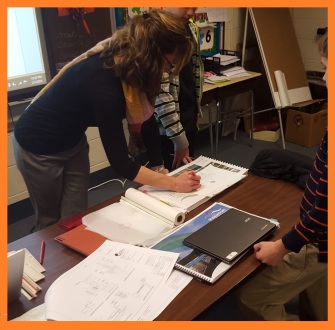This is the final part in my three-part series on how to integrate a novel into your curriculum. For my first post, on how to hook your students before they even read the first page, click here and for my second post on keeping students engaged during a novel-study, click here.
 The idea of writing this post is what inspired my idea for this three-part series in the first place. My favorite part about teaching is coming up with culminating activities. Sure, you can give a test and be done, but I’ve never had any former students coming back to visit me to reminisce about that test they took. I’ve never had students say they remember a book because “that question 24 really stuck” with them.
The idea of writing this post is what inspired my idea for this three-part series in the first place. My favorite part about teaching is coming up with culminating activities. Sure, you can give a test and be done, but I’ve never had any former students coming back to visit me to reminisce about that test they took. I’ve never had students say they remember a book because “that question 24 really stuck” with them.
Tests have their place, but they don’t hold a match to project-based learning when it comes to making something stick. And I’m not just talking about dioramas or posters. A good project will still assess students knowledge of a text – not just their knowledge of a glue gun – so it can totally replace the need of a test.
Not sure how to use a project to culminate your novel-reading? Maybe some of the suggestions below can spark some inspiration!
Make a Character Evolution Timeline
What I Do:
- Typically, students have been assigned a character at the beginning and have been keeping notes on their character during the course of the novel
- At the end, students make timelines based on plot events in the novel showing textual evidence of different social and emotional changes their character went through
When I’ve Done This:
- This is perfect for novels where the characters either go through huge changes (Red Scarf Girl) or where there are a variety of characters (Westing Game)
Why I’ve Done This:
- This product is a FANTASTIC showcase of student knowledge
- Students need to use textual evidence
- It engages higher level thinking skills
- It stretches into social studies with the timeline element
For a FREE download of how I used the Character Timeline in Westing Game, click here
Make a Monument

I contacted a local architect agency to talk to my 5th graders about design
What I Do:
- Students create blueprints, and then 3-D replicas of monuments that they would erect to mimic a theme/symbol/character/etc. we’ve been reading about.
- I have students choose every detail, down to materials used and location of monument, to reflect theme
When I’ve Used This:
- After reading Code Talkers and studying the Navajo Code Talkers monument in Arizona, my 5th graders created monuments to honor a group of their choosing
- To culminate an 8th grade Holocaust literature unit students work in teams to create Holocaust monuments for Ohio
Why I’ve Used This:
- You can focus on any or all of the following standards
- Demonstrates a theme by creating a structure that conveys the same theme (CCSSRL.2)
- Focus on symbolism (CCSSRL.2)
- Honor a character (CCSS RL.3)
- Use of language (CCSSRL.4) – have students choose specific phrases to carve into it
- Allows students to create a blueprint, or bump it up into a full blown creation
- Options for interdisciplinary connections by having them include measurements (math) and building materials (science)

Purchase the materials for one of my Monument projects here. It’s in a word document, so it’s easy to adapt for different novels.
Make a Scrapbook
What I Do:
- I start this project halfway through a novel so students can work on it as we progress (helps show character development)
- I have students choose a character to take on and to write all captions/postcards/journals using their tone from their point of view.
When I’ve Used This:
- After reading The Watsons Go To Birmingham with my 6th graders
- As a follow-up project for a Holocaust research study
- To culminate our reading of Boy in 7th grade
Why I Do This:
- So easy to manipulate to fit the standards I taught during the unit
- Scrapbooks can have more than just pictures – I’ve had students include diaries, postcards, tickets and memorabilia, photos and captions and museum pamphlets
- My students have said, “This was a lot of work – but it was really really fun!”
Purchase my Watsons Go To Birmingham scrapbook project & rubric here
More Novel Culminating Projects I’ve Done…
- After reading To Kill a Mockingbird, I’ve had students put on their own dramatic interpretation of the novel
- After “The Tell-Tale Heart” (I know, I know, it’s a short story not a novel) students have done a mock trial, putting the Narrator on the bench
- After reading Boy students have written their own memoirs
- After reading Iqbal, students created their own anti-child labor campaigns
- After reading The Lion, The Witch and the Wardrobe, students created their own fantasy settings (I based this off of my Create a Country project)
- After reading A Wrinkle in Time, students invented their own sci-fi products that would be useful in one of the settings or for one of the characters

We took it a step further and made our own planets, as well as a trade route for our sci-fi products! (Perfect blend of literature and economics!)
How do YOU wrap up your novel studies? I would love to get some new ideas. Leave a comment or tweet at me @creativelyteach
